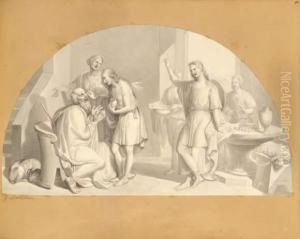Gaspare Martellini Paintings
Gaspare Martellini was an Italian artist, born in 1800 in Florence, Italy, during a period of significant cultural and artistic development. Although not as widely known as some of his contemporaries, Martellini was a part of the vibrant art scene in Italy in the early 19th century. He is often remembered for his contributions to lithography, a relatively new printmaking technique at the time, which allowed for the reproduction of artworks and dissemination of visual culture.
Martellini's work was influenced by the Neoclassical style, which was predominant during his lifetime. This movement sought to revive the classical art and architecture of ancient Greece and Rome. His lithographs often featured classical themes and subjects, reflecting the aesthetic preferences of the era.
In addition to his work in lithography, Martellini was also known for his painting and drawing. He received a traditional art education, which was typical of the time, focusing on drawing from life and studying the works of past masters. His training would have included copying the works of Renaissance artists, which was a common practice to learn techniques and compositions.
Tragically, Gaspare Martellini's life and career were cut short when he died at the young age of 33 in 1833. Despite his early death, his works continued to be appreciated by collectors and art enthusiasts. Martellini's legacy lies in his contribution to the development of lithography in Italy and his maintenance of classical themes in a changing artistic landscape.
The brief span of his career means that detailed records of his life and work are not as extensive as those of more famous artists of his time. Consequently, Martellini's biography is not as well-documented, and much of what is known about him comes from the study of his surviving works and the art historical context in which he created them.

